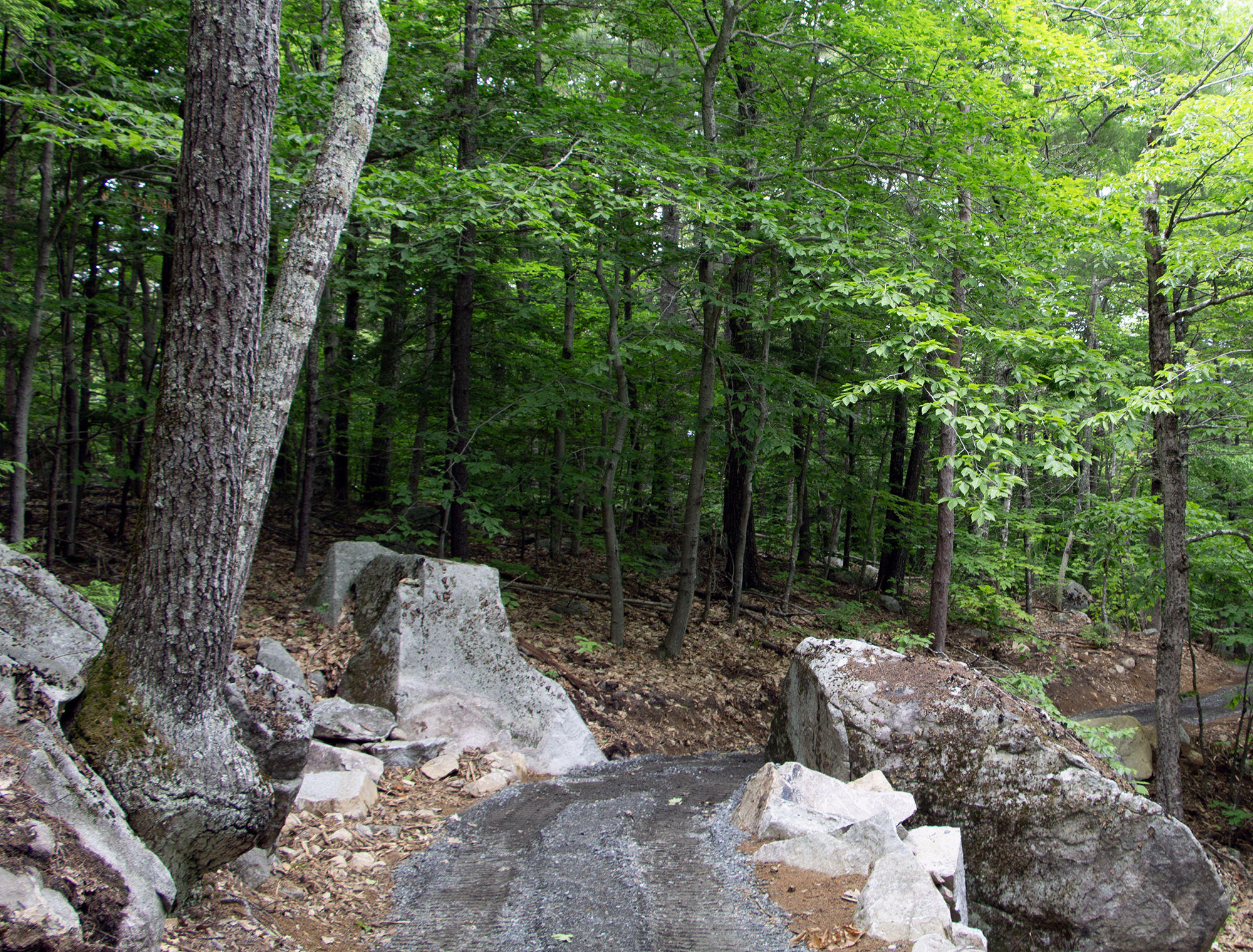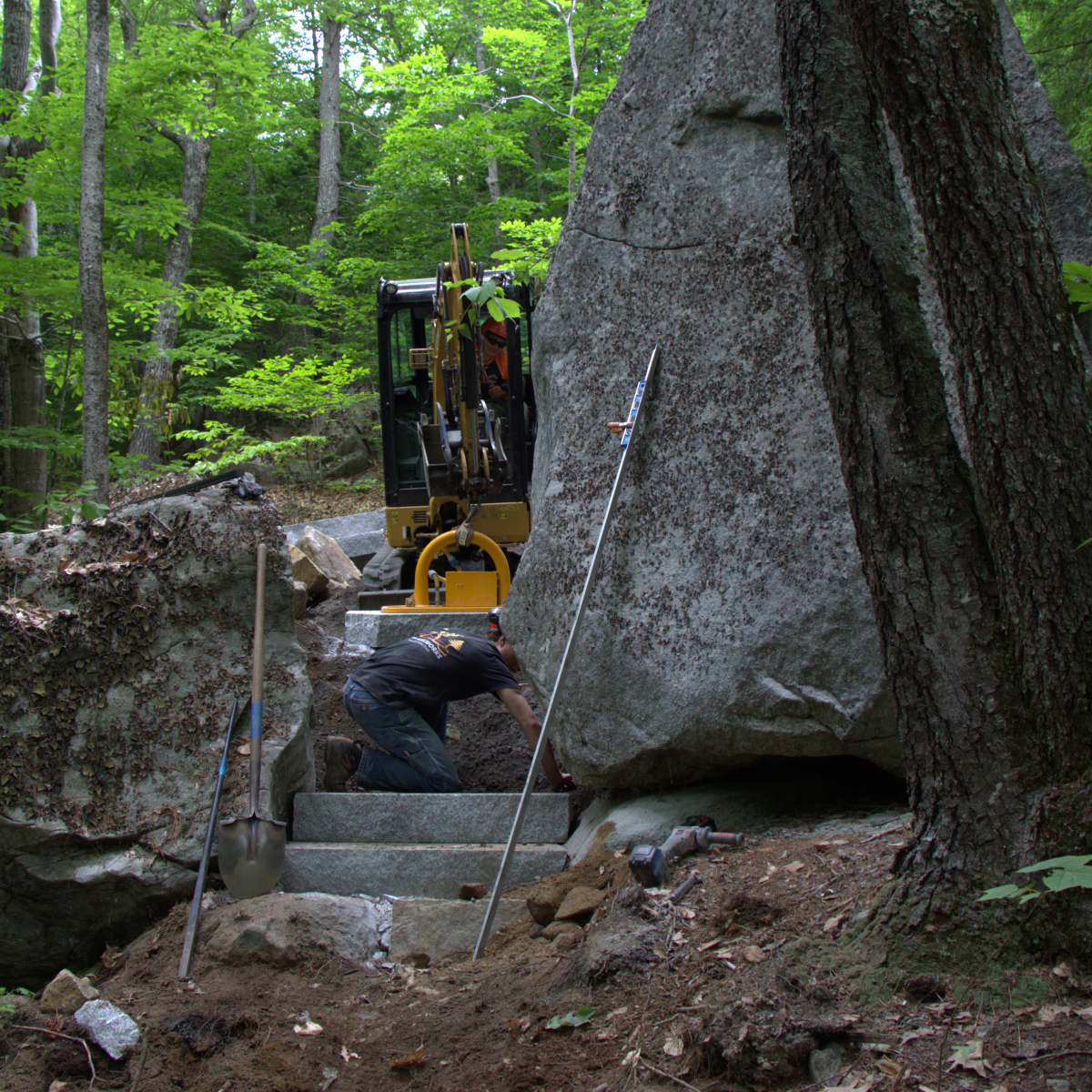
Crews were making progress on the new section of the Main Trail last month. (Photo: Anna Berry)
For Jed Talbot, building and upgrading recreational trails has proven to be a difficult profession — but that’s the point.
“It’s one of the hardest things I’ve tried to do,” he said. “I’m a person who thrives on challenges and I just really love working outside.”
Talbot, the owner of a Maine company that provides trail planning, design, and construction services called of OBP Trailworks, was in the middle of a long workday at Mount Major in Alton, where the Society for the Protection of New Hampshire Forests began an ambitious upgrade to the most popular route to the summit, the Main Trail, in May.
OBP Trailworks and Town 4 Trails Services are working with the Forest Society to construct a sustainable trail to take the place of about 1/3 mile of the existing Main/Blue Trail by the end of August. Lower sections of the Main Trail had become extremely eroded due to the steep grades on sub-optimal soil combined with the impact of 80,000 visitors each year — approximately 480 million footsteps annually.

In addition to creating a more enjoyable hiking experience, the new trail section will require less maintenance over time, according to Forest Society Reservation Stewardship and Engagement Director Carrie Deegan. It will also be a major ecological improvement, reducing runoff and silting into Lake Winnipesaukee. The old section of the Main Trail will be closed, stabilized, and rehabilitated.
With a rapidly changing climate, building sustainable trails and upgrading old ones is more important than ever.
Last July, heavy rain washed out several roads in Alton, including Route 140. However, a smaller section of the Main Trail at Mt. Major that was upgraded in 2020 to improve drainage remained completely intact.
“We’re still trying to get a handle on how to plan for the future in the face of what’s been happening with the recent weather patterns,” Talbot said. “But as we’ve been learning more about what’s been happening with the weather, advancements in trail design have been coming up at the same time.
“There’s a much larger focus on sustainable trails — trails that are sustainable for the environment and for the humans using them.”
What does “sustainable” mean?
“Sustainable trails are designed to control the environmental impacts that hikers have on a landscape,” explained Dylan Summers, the Forest Society’s manager of stewardship projects. “They concentrate and minimize the impact of thousands of footfalls, preventing greater harm and degradation to the surrounding landscape.”
For land conservation and environmental organizations that create and care for outdoor trails, sustainable trail building practices can be used at both well-used trails, like at Mount Major, and lesser-known destinations.
“Trails should ideally be designed to be appropriate for the amount of use that they see, being more developed in areas with heavier use than in areas that see more sporadic use,” Summers said. “They are designed to minimize maintenance, so that the trail can be kept in good condition with as little cost and effort as possible.”
Good design goes a long way, but this can be hard in a state where many trails date back more than a century.
“Early trails in New England were often sited where they provided the shortest and most convenient route to the summit — often running directly uphill or utilizing old, existing logging roads themselves built for short-term use,” Summers said. “A greater understanding of the long-term impacts and issues arising from unsustainable trail construction came later, as trail maintainers worked to repair the problems of old trails.”
Trail workers have since learned how to build trails with the landscape rather than against it.
“Aligning the trail with the natural contours of the terrain facilitates good drainage and prevents erosion issues,” Summers said. “Trails climb gradually across slopes rather than directly up them, allowing water to run off of trails instead of down them, minimizing erosion.”

Learning from the Landscape
As he took a break from excavating large boulders and stumps on the new section of the Main Trail at Mt. Major, Talbot said building sustainable trails involves a lot of troubleshooting.
“Often times we’re basically bringing in the tools and utilizing the resources that we have available to us to try to make our trails,” he said. “Every stump that we pull out of here we’re going to use on the restoration of the old trail section… all of the trees that we cut down will also be used in the restoration of the old trail.”
Even with the extreme weather events spurred by climate warming, Talbot said he’s seen land managers and trail builders rise to the new challenges.
“Although we’re seeing more drastic water events, we’re also seeing better trails get built on the ground and newer techniques for retrofitting old trails to try to accommodate what’s happening with the weather patterns,” he said. “I’m optimistic for the future.”
- Learn more about the Mount Major project: forestsociety.org/visitmtmajor
Anna Berry is the director of communications and digital outreach at the Forest Society. She can be reached at aberry@forestsociety.org.

Support Sustainable Trail Improvements at Mount Major!
Please join us in being good stewards of Mt. Major by donating to the Mt. Major Main Trail Project today! You will be able to walk on your investment for many years to come!
